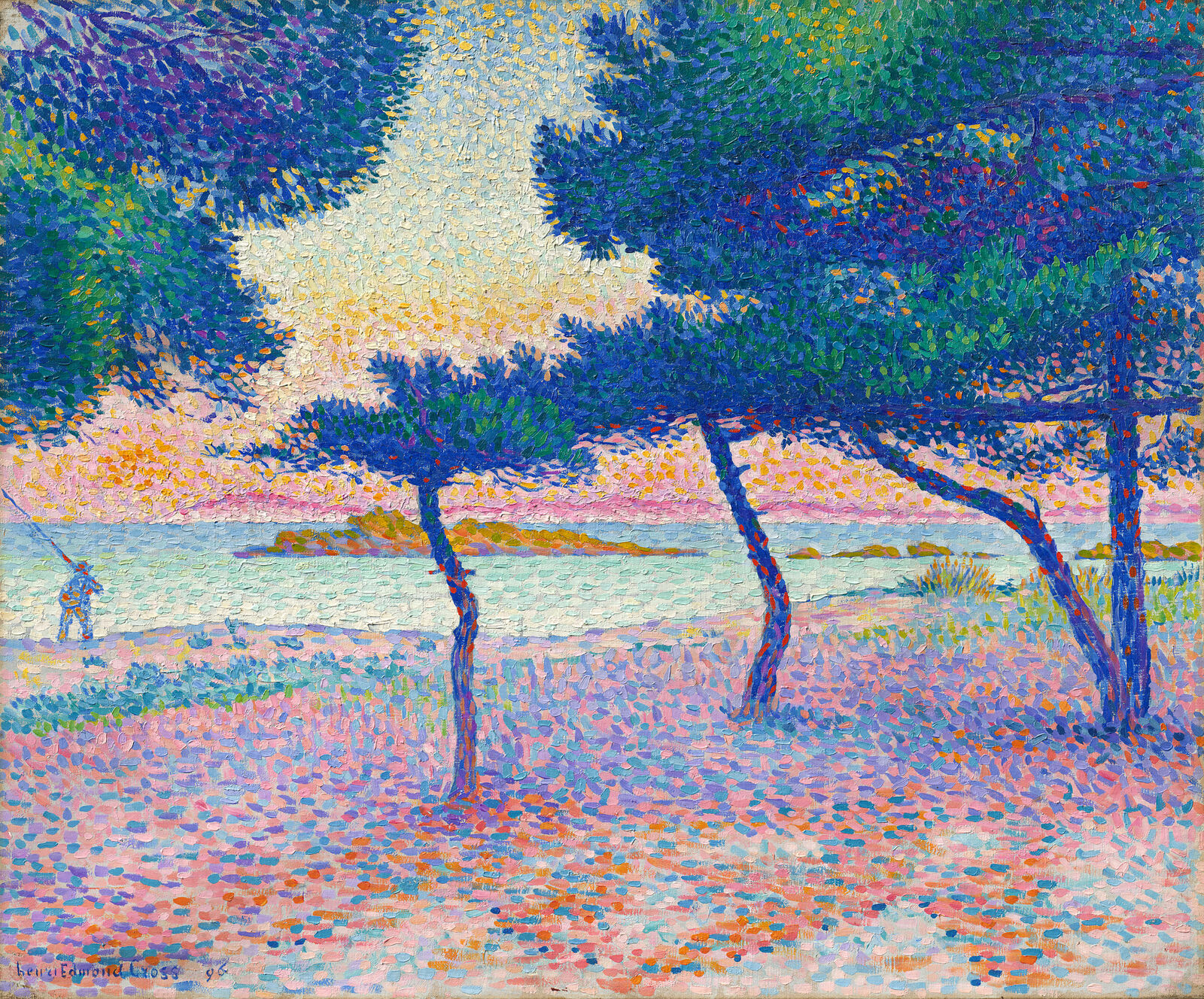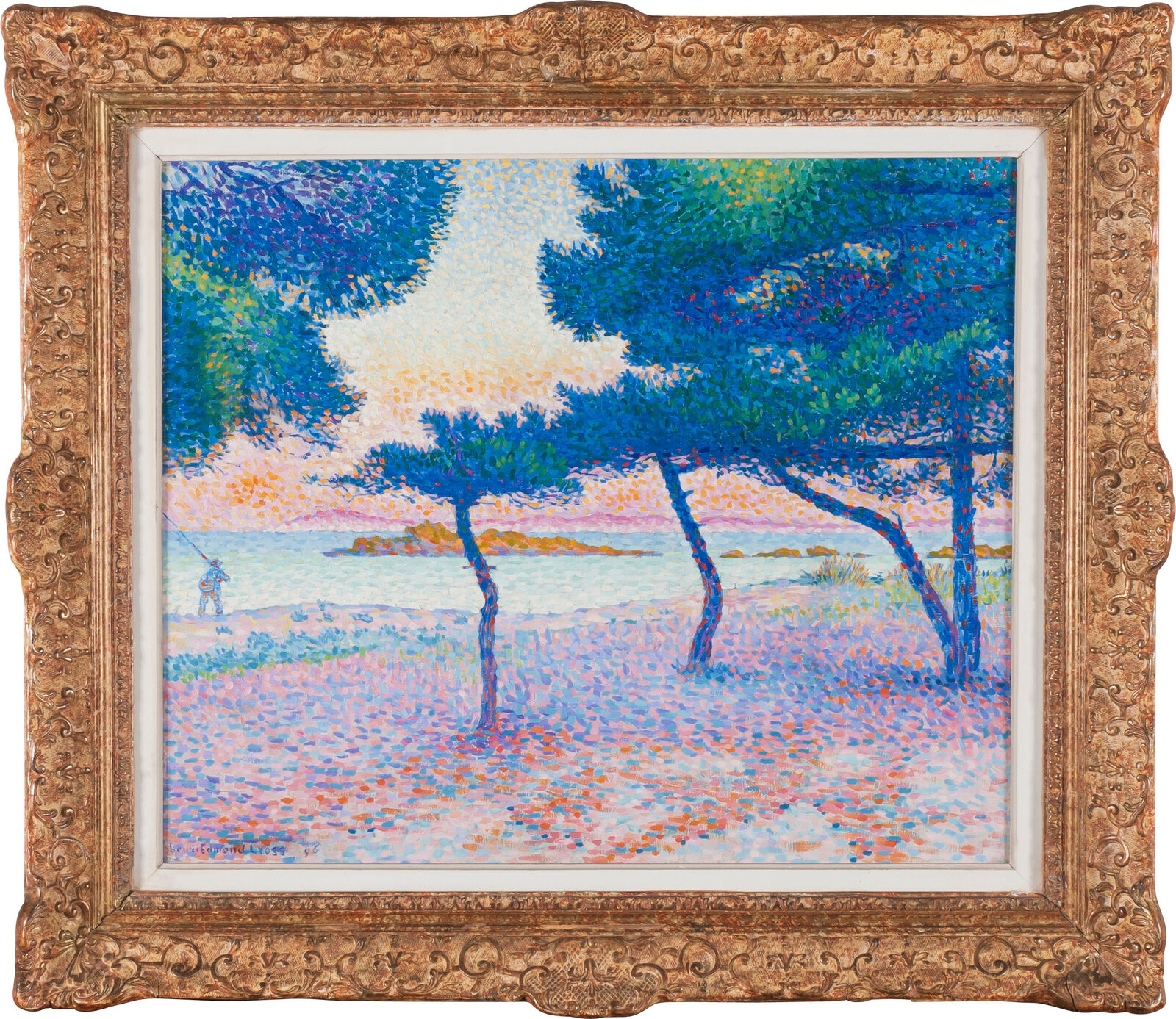Henri-Edmond Cross
The Beach at Saint-Clair, 1896
On view
3 further works by Cross
Copy link
Oil on canvas, 54 x 65 cm
Signed and dated lower left: Henri Edmond Cross 96
Inv.-no. MB-Cro-03
In 1891 Henri-Edmond Cross moved to the Côte d’Azur, which he glorified as an earthly paradise in his Pointillist paintings. The jewellike colors and the shimmering of the setting sun bestow a celebratory evening atmosphere on the grove of pines. The intense colors attest to Cross’s exchange with his friend Paul Signac, who also settled on the Mediterranean.
In the early 1890s Cross moved to the French Riviera, where he settled first in Cabasson and then in the small coastal town of Saint-Clair. From this point on, the beauty of the Mediterranean landscape became the primary subject of his painting. In numerous sun-drenched images of nature, he transfigured the Riviera into an Edenic place—an idealization that echoed the burgeoning status of the region as a Southern tourist paradise. Early depictions of the coast such as Calanque des Antibois (ca. 1891–92, National Gallery of Art, Washington) or Beach at Cabasson (ca. 1891–92, The Art Institute of Chicago) show close adherence to the principles of Divisionism developed by Georges Seurat in the late 1880s. The Beach at Saint-Clair, on the other hand, is more typical of Cross’s work from the mid-1890s onwards, when he abandoned the fine color nuances and tiny dots that had characterized Seurat’s style. Instead, he now employed pure, intensely glowing tones applied to the canvas in broad strokes, often with an impasto, mosaic-like texture. Here, the brilliant jewel-like colors imbue the evening view of a pine copse by the sea with a dreamy mood akin to another, thematically very similar work by Cross, The Evening Air (Musée d’Orsay, Paris). The pronounced color contrasts, the interplay of pink and violet hues below the trees with the dark blue and green tones of the decoratively composed pines in the upper half of the picture, are all characteristic of this second phase of Neo-Impressionism.
In 1896 Cross painted another view of the pine copse near his house in Saint-Clair, a work that shows a close compositional relationship to the composition in the Hasso Plattner Collection: Pines Along the Shore, now in the collection of the Metropolitan Museum of Art in New York.
Daniel Zamani
Salon des Indépendants, Palais des Arts libéraux, Paris, April 3–May 31, 1897, no. 278 (?)
Modern Art Classics: Liebermann, Munch, Nolde, Kandinsky, Museum Barberini, Potsdam, January 23–May 28, 2017
Henri-Edmond Cross: peindre le bonheur, Musée des Impressionnismes, Giverny, July 27–November 4, 2018
Color and Light: The Neo-Impressionist Henri-Edmond Cross, Museum Barberini, Potsdam, November 17, 2018–February 17, 2019, no. 26
Impressionism: The Hasso Plattner Collection, Museum Barberini, Potsdam, from September 5, 2020
Henri-Edmond Cross, dans la lumière du Var. « Le plus beau pays du monde», Musée de l'Annonciade, Saint-Tropez, July 10–November 14, 2023, no. 14
1920s or 1930s, Private
collection, France
n.d., Private collection, France, inherited from the above
February 5, 2013, Sotheby’s, London, lot 2, consigned by the above
Isabelle Compin, H. E. Cross, Paris 1964, no. 58a, p. 149, ill. p. 149
Color and Light: The Neo-Impressionist Henri-Edmond Cross, exh. cat. Museum Barberini, Potsdam 2018, no. 29
Henri-Edmond Cross, dans la lumière du Var: « Le plus beau pays du monde», exh. cat. Musée de l'Annonciade, Saint-Tropez 2023, no. 14, p. 24, ill. p. 25
Barberini Audioguides
Do you have suggestions or questions?
sammlung@museum-barberini.de.

